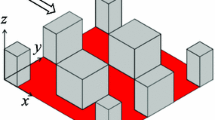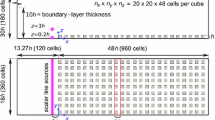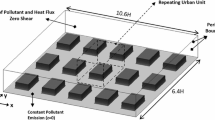Abstract
A Reynolds-averaged Navier–Stokes microscale model is used for the simulation of the effect of unstable thermal stratification on the flow within an aligned configuration of building-like cubes as used in Santiago et al. (Urban Clim 9:115–133, 2014). The spatially-averaged results show increased dispersive fluxes, turbulent length scales and sectional drag coefficient. An extension of K-theory is presented to parametrize the sum of the turbulent and dispersive fluxes, and the length scale and drag coefficient increases are parametrized as functions of the ratio of buoyant and inertial forces. This approach improves the results of urban canopy parametrization simulations inside and above the urban canyon and represents the first attempt to account for the dispersive fluxes and the effect of solar radiation on the flow.












Similar content being viewed by others
References
Bougeault P, Lacarrere P (1989) Parameterization of orography-induced turbulence in a mesoscale model. Mon Weather Rev 117:1872–1890
Brown M, Williams M (1998) An urban canopy parameterization for mesoscale meteorological models. AMS 2nd urban environment symposium. Albuquerque, NM, pp 144–147
Cai XM (2012) Effects of wall heating on flow characteristics in a street canyon. Boundary-Layer Meteorol. 142:443–467
CD-adapco (2012) User Guide STAR-CCM+ Version 7.04.011. Cd-adapco, p 11448
Coceal O, Belcher SE (2004) A canopy model of mean winds through urban areas. Q J R Meteorol Soc 130:1349–1372
Coceal O, Thomas TG, Castro IP, Belcher SE (2006) Mean flow and turbulence statistics over groups of urban-like cubical obstacles. Boundary-Layer Meteorol 121:491–519
Di Sabatino S, Solazzo E, Paradisi P, Britter R (2008) A simple model for spatially-averaged wind profiles within and above an urban canopy. Boundary-Layer Meteorol 127:131–151
Grimmond CSB, Oke TR (1999) Aerodynamic properties of urban areas derived from analysis of surface form. J Appl Meteorol 38:1262–1292
Hamdi R, Masson V (2008) Inclusion of a drag approach in the Town Energy Balance (TEB) scheme: offline 1D evaluation in a street canyon. J Appl Meteorol Clim 47:2627–2644
Kanda M, Kawai T, Kanega M, Moriwaki R, Narita K, Hagishima A (2005) A simple energy balance model for regular building arrays. Boundary-Layer Meteorol 116:423–443
Kondo H, Genchi Y, Kikegawa Y, Ohashi Y, Yoshikado H, Komiyama H (2005) Development of a multi-layer urban canopy model for the analysis of the energy consumption in a Big City: structure of the urban canopy model and its basic performance. Boundary-Layer Meteorol 116:395–421
Krayenhoff ES, Voogt JA (2007) A microscale three-dimensional urban energy balance model for studying surface temperatures. Boundary-Layer Meteorol 123:433–461
Krayenhoff ES, Santiago J-L, Martilli A, Christen A, Oke TR (2015) Parameterization of drag and turbulence for urban neighbourhoods with trees. Boundary-Layer Meteorol 156:157–189
Leonardi S, Castro IP (2010) Channel flow over large cube roughness: a direct numerical simulation study. J Fluid Mech 651:519–539
Martilli A, Santiago JL (2007) CFD simulation of airflow over a regular array of cubes. Part II: analysis of spatial average properties. Boundary-Layer Meteorol 122:635–654
Martilli A, Clappier A, Rotach MW (2002) An urban surface exchange parameterization for mesoscale models. Boundary-Layer Meteorol 104:261–304
Masson V (2000) A physically-based scheme for the urban energy budget in atmospheric models. Boundary-Layer Meteorol 94:357–397
Masson V, Seity Y (2009) Including atmospheric layers in vegetation and urban offline surface schemes. J Appl Meteorol Clim 48:1377–1397
Park SB, Baik JJ, Raasch S, Letzel MO (2012) A large-eddy simulation study of thermal effects on turbulent flow and dispersion in and above a street canyon. J Appl Meteorol Clim 51:829–841
Santiago JL, Martilli A (2010) A dynamic urban canopy parameterization for mesoscale models based on computational fluid dynamics Reynolds-averaged Navier-Stokes microscale simulations. Boundary-Layer Meteorol 137:417–439
Santiago JL, Coceal O, Martilli A, Belcher SE (2008) Variation of the sectional drag coefficient of a group of buildings with packing density. Boundary-Layer Meteorol 128:445–457
Santiago JL, Dejoan A, Martilli A, Martin F, Pinelli A (2010) Comparison between LES and RANS computations for the MUST field experiment. Part I: study of the flow when the incident wind direction is perpendicular to the array. Boundary-Layer Meteorol. 135:109–132
Santiago JL, Coceal O, Martilli A (2013) How to parameterize urban-canopy drag to reproduce wind-direction effects within the canopy. Boundary-Layer Meteorol 149:43–63
Santiago JL, Krayenhoff ES, Martilli A (2014) Flow simulations for simplified urban configurations with microscale distributions of surface thermal forcing. Urb Clim 9:115–133
Simón-Moral A, Santiago JL, Krayenhoff ES, Martilli A (2014) Streamwise versus spanwise spacing of obstacle arrays: Parameterization of the effects on drag and turbulence. Boundary-Layer Meteorol 151:579–596
Sini JF, Anquetin S, Mestayer PG (1996) Pollutant dispersion and thermal effects in urban street canyons. Atmos. Environ. 30:2659–2677
Uehara K, Murakami S, Oikawa S, Wakamatsu S (2000) Wind tunnel experiments on how thermal stratification affects flow in and above urban street canyons. Atmos. Environ. 34:1553–1562
Uno I, Ueda H, Wakamatsu S (1989) Numerical modeling of the nocturnal urban boundary layer. Boundary-Layer Meteorol 49:77–98
Xie X, Liu CH, Leung DYC, Leung MKH (2006) Characteristics of air exchange in a street canyon with ground heating. Atmos. Environ. 40:6396–6409
Acknowledgments
We acknowledge Dr. Scott Krayenhoff for his help in revising the paper.
Author information
Authors and Affiliations
Corresponding author
Rights and permissions
About this article
Cite this article
Simón-Moral, A., Santiago, J.L. & Martilli, A. Effects of Unstable Thermal Stratification on Vertical Fluxes of Heat and Momentum in Urban Areas. Boundary-Layer Meteorol 163, 103–121 (2017). https://doi.org/10.1007/s10546-016-0211-4
Received:
Accepted:
Published:
Issue Date:
DOI: https://doi.org/10.1007/s10546-016-0211-4




